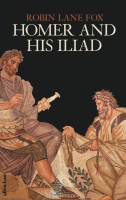
Allen Lane (2023) h/b 442pp. £30 (ISBN 9780241524510)
The ancients knew nothing about emergence of the text of the Iliad nor anything about Homer, whom they believed to be its author. Nor do we. This is exactly the sort of challenge that appeals to Robin Lane Fox, and here he takes it on in his usual style, at full gallop. It is rather disappointing to have to report that, in the absence of any secure evidence on either question, even he has to admit defeat, but in presenting his opinion on both matters, his masterful survey of the territory provides the reader with an exciting ride.
After a brief introduction to the story of the Iliad, the metre, the scope of its human interest and the skill with which Homer tells it, the first half of the book deals with the big historical questions. On the assumption that there was a Homer who was alone responsible for the epic, LF proposes that the geographical data provided by the story-line suggest that Homer based the battle on his personal knowledge of the impressive site of Troy itself, though since oral poets do not preserve the past but rather invent and distort it, the Trojan War was an invention of eastern Greeks of the 11th to 9th C and Homer’s text presented a cultural amalgam of events vaguely remembered from the past to generate an imagined world of heroes. Here I would have welcomed a reference to Hermann Strasburger’s now translated essay Die Soziologie der homerischen Epen (1952) which shows how the poet balanced the heroic world with the agricultural setting within which it took place.
LF draws on the latest evidence for the dating of the Greek alphabet to argue that the poet, working in a tradition of oral poetry going back hundreds of years, produced his unique text of the Iliad between 750-730 BC (earlier than most scholars do). Here he pays close attention to the work of those who from the 18th century—long before Milman Parry entered the scene—saw analogies between Homer’s work and that of various traditions of oral poetry from Europe, the Near East and central Asia, suggesting that Homer need not have sung the whole epic to the lyre, and that dramatic pauses and gestures in performance surely played a part.
LF also surmises that our text derives from Homer’s personal dictation of it, at a slower pace than normal—perhaps 1000 verses a day—to an assembly of scribes (he reports on a conclusion that the hides of 86 goats would have been enough to contain it); and that Homer left this text as an inheritance to his sons to memorise and perform for a fee.
All this represents a substantial work of scholarship, composed with LF’s usual energy and authority, and supported by a number of photographic illustrations, but always carefully hedged with warning notes such as ‘I believe that...’, ‘It looks as if...’, and so on.
In the second half, LF provides a fascinating personal view of how Homer set about populating and shaping the Iliad, concluding persuasively that, with the exception of book 10 and a few other passages, the carefully controlled plot, timescale, and character depiction provide clear evidence that it was the work of a single master-poet. To do this, he writes in detail, but also incisively, about heroism, heroic ethics, shame and glory, the characters (whom Homer as a rule does not himself describe: he leaves them to talk and act) and swift-footed Achilles—with a delightful interlude on (what else?) ‘Equine Poetics’!
Two omissions did, however, surprise me. Nothing is said in detail about how Homeric warfare actually worked (Franz Albracht’s now translated Kampf und Kampfshilderung bei Homer [1886 and 1895]—Albracht fought in the Franco-Prussian war of 1870-1—still seems to me the best treatment), nor about Homer’s handling of typical scenes, widely repeated with elegant variations across the epic (Walter Arend’s Die typischen Scenen [sic] bei Homer [1933], and Bernard Fenik’s Typical Battle Scenes in the Iliad [1968] are the key texts here). Both would seem to me to support LF’s argument for a single author. A note on Homeric humour too would have been helpful when he discusses Hera’s seduction of her husband in Iliad 14.
The final section on ‘Parallel Worlds’ discusses the intersection of the heroes with that of the gods, the world of women, the natural world, in which Homer’s similes feature large, and the shield of Achilles made for him by Hephaistos. He ends with an extended reflection on C.S. Lewis’s reference to two particular qualities of the Iliad: ‘its unwearying splendour and ruthless poignancy’. LF identifies pity and pathos, hardened by irony, at the heart of its poignancy and ruthlessness. The reader will be grateful that the author finds no need for the excruciating contortions of modern literary criticism to make his case.
Those who know Lane Fox’s work will not be surprised that there is an unmatchable confidence and clarity about this book. It is also heartfelt: of his passion for Homer, there can be no doubt. One gets quite swept up in the thrill of the chase. Whether one agrees with it or not is a quite different question.
The extensive scholarly notes and references are placed at the back in very small print, together with a bibliography, notes on the illustrations and an index.
Peter Jones
